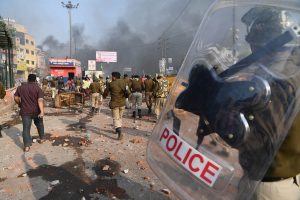
The mark of a democracy is to let people express their dissent without any reprehension or threat. Democracy itself can only work so long as the differences between groups do not impair a broad substrate of shared values.
The right to assemble peacefully has been enshrined in Article 19(1)(b) of the Indian Constitution. Amid the increasing police brutality against the anti-CAA protestors, the Allahabad High Court’s recent decision of directing the state to give compensation to the AMU students who were injured during lathi-charge and asking the authorities to take action against the erring police officials is nothing less than the silver lining in this saga of despair.
The principle governing the use of force states that: “Force should only be used when it is necessary, it should be minimum and proportional to the situation and its use should be discontinued as soon as the danger to life and property subsides” and “While firing, the aim should be kept low and directed at the most threatening part of the crowd and firing should stop at the moment the crowd starts to or shows signs to disperse”. This simply was not followed. Shooting the protestors above waist i.e. in the face and chest, the Police openly flouted the most basic regulations: Section 129 and 130 of Cr.P.C. and Article 14 of ‘U.N Basic Principles for the Use of Force and Firearms’.
Various fact-finding committees and human rights organizations have claimed that most of the deaths, during the protest, occurred due to the police firing, directly aimed at the chest and the face of the victims and the same has been reiterated by the families of the victims. A jury comprising Justice (Retd.) A.P. Shah and Justice (Retd.) Sudarshan Reddy and another eminent citizen also criticized the conduct of UP police. Whereas Bijnor police itself accepted a fatality from Police firing, the DGP of UP, after this incident, claimed that not a single bullet was fired. The police were also seen damaging the private properties.
Earlier too, in a series of a sting operation, it comes into light that the policemen in India were ready to frame innocent people and kill them in staged encounters in exchange for bribes, publicity, and promotions. During protests too, Police personnel dispersing crowds were seen over-exercising their authority. This behavior stems partly because of the failure to establish liability to a particular constable or police officer and partly because the senior police officers in an order to save their department from humiliation try every possible way to conceal the misfeasance of lower-ranking officials.
In the U.K. the Police Chief is vicariously held liable for every wrong committed by the officers during their employment and a police fund has also been created to award the cost to the victims. As per Section 88 of the Police Act, Police Chief is vicariously liable for any wrongdoings by their constable in the course of their employment.
In a recent case of Robinson v Chief Constable of West Yorkshire Police [2018] the Supreme Court of UK while holding that Chief Constable is liable in damages to claimant, observed, that where a third party such as a pedestrian is injured as a result of a negligent arrest on the street by a police officer, the police are liable in negligence where that injury was a reasonably foreseeable consequence of the police’s actions.
In yet another case of Ashley v Chief Constable of Sussex Police, the Chief Constable was held vicariously liable for the damages wherein negligent shooting of a suspected criminal was conceded by the Police officers.
Therefore any misfeasance, failure to follow the reasonable duty of care or negligence by the police officials in the exercise of their duty is sufficient to bring up a claim against the Chief Officer.
To control the conduct of a hierarchy, it is better to internalize the controlling norm at the top and let it seep down than to inject the norm at the bottom and hope that it will spread and rise. Moreover, it is a matter of fact that during crowd control situations the system of identification of uniformed police is inadequate; In theory, the uniformed officer may be identified by the badge pinned to his chest: yet in moments of stress, these badges disappear and in those circumstances, the failure to identify the particular police officer who transgressed his lawful authority would preclude the bringing of an action. If the Chief police officer himself is vicariously held liable, then he will translate that deterrence through the force using police disciplinary action. The creation of police funds will bring certainty to the Plaintiff that he/she may be compensated adequately and shall encourage him to bring well-grounded actions against the Police.
This blog is authored by Divyank Yadav. He is a law student from Dr. Ram Manohar Lohiya NLU, Lucknow.
